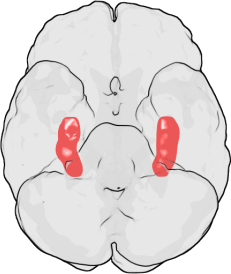Rising Stars - Hippocampi and Taxi Drivers
Interview with
Now, we've got a new feature for the New Year. Each term Cambridge University's Rising Stars project helps young researchers to tell the world about their work. We teamed up with a group of rising stars so that you can find out what the next generation of top scientists are up to. Seeing as we've been talking about the brain this week we thought we would start you off with a neuroscientist. Here's this week's rising star and that's Hannah Critchlow.
 Hannah - What happens to our brains as we learn, remember and forget? Are there any physical changes we can see? Can we develop new drugs to improve our memories and turn us all into know-it-alls? How do you link taxi drivers, seahorses and spines? The brain is the most complicated and active part of our body, accounting for just two percent of our total body mass yet greedily consuming over 20% of our daily energy quota. The brain is only 1.5kg. But for neuroscientists like myself the brain presents the most enigmatic questions of the entire body. There are over 100 billion nerve cells in our brains and each cell is connected with up to ten thousand others. Communicating with each other like an intricately designed and sometimes flawed computer network system. One brain region that I'm particularly interested in is the hippocampus which is shaped like a seahorse from the Greek hippos, meaning horse and campi, meaning curve. Research on the hippocampus has provided insight into its function. Hippocampi brain injury patients have problems with learning, spatial navigation, memory and planning: showing that this region is involved in these higher cognitive functions. Scientists at University College London have found that London taxi drivers have substantially larger hippocampi than most people. It seems that by using their spatial navigation skills and memory, London cabbies exercise part of their hippocampi and increase its volume in much the same way that physical exercise builds muscles. The biggest ever winning score on Mastermind? A cabbie. He must have packed an extremely large seahorse.
Hannah - What happens to our brains as we learn, remember and forget? Are there any physical changes we can see? Can we develop new drugs to improve our memories and turn us all into know-it-alls? How do you link taxi drivers, seahorses and spines? The brain is the most complicated and active part of our body, accounting for just two percent of our total body mass yet greedily consuming over 20% of our daily energy quota. The brain is only 1.5kg. But for neuroscientists like myself the brain presents the most enigmatic questions of the entire body. There are over 100 billion nerve cells in our brains and each cell is connected with up to ten thousand others. Communicating with each other like an intricately designed and sometimes flawed computer network system. One brain region that I'm particularly interested in is the hippocampus which is shaped like a seahorse from the Greek hippos, meaning horse and campi, meaning curve. Research on the hippocampus has provided insight into its function. Hippocampi brain injury patients have problems with learning, spatial navigation, memory and planning: showing that this region is involved in these higher cognitive functions. Scientists at University College London have found that London taxi drivers have substantially larger hippocampi than most people. It seems that by using their spatial navigation skills and memory, London cabbies exercise part of their hippocampi and increase its volume in much the same way that physical exercise builds muscles. The biggest ever winning score on Mastermind? A cabbie. He must have packed an extremely large seahorse.
Schizophrenic patients in contrast, have smaller hippocampi volumes. I'm interested in the reason why. New research has shown the schizophrenic patients have fewer connections between their nerve cells, thereby accounting for their smaller hippocampi. The majority of connectivity between brain cells occurs on structures called dendritic spines which are miniscule: one thousand, five hundred time smaller than a pinhead. Dendritic spines extend from nerve cells like buds extending from a twig. New dendritic spines form as we learn, becoming stable, mature spines as we memorise. Schizophrenic patients have fewer dendritic spines than healthy individuals. This might also be why they show impairments and cognition. If you imagine an aerial shot of London with many different roads branching off between landmarks this could be compared to a healthy functioning brain with high levels of connectivity. On the other hand, a schizophrenic patient's brain would resemble the less convoluted road system of a newer city with fewer connections.
My investigations have shown that we could potentially improve the treatment of schizophrenia by designing new drugs which specifically cultivate dendritic spine formation. As a by-product of this we may also uncover new ways of boosting memory power for students like myself. Heady implications.
- Previous How Addiction Shapes the Brain
- Next Why do Diets Fail?









Comments
Add a comment